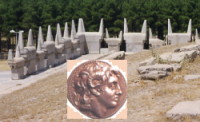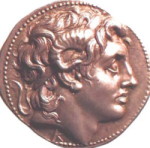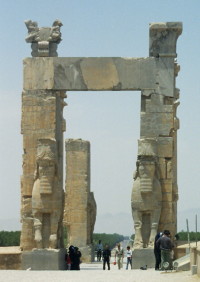
Photo. Strange stone sculptures in ancient Persepolis, Persia,
Iran.
Have these mysterious stones sculptures
been shaped to symbolise Alexander the Great wearing a helmet
with horns, or has it something to do with Norwegian
Vikings? Anyway Alexander the Great sat his footprints deeply in Persia, and they are
visible.
Not inspired by the
Vikings?
Have the Vikings ever been to Persepolis? The city of
Persepolis is from around 500 - 300 B.C. When I was in
Persepolis in July
this year I heard someone mentioned that these stone sculptures could have
something to do with Norwegian Vikings, but how could this make sense? Of course
it depends on when they were designed and raised. As
kno
wn from history that the Vikings used helmets (hats) with
horn, but the Viking era spanned from about 750 to 1050. So where is the
connection?
The Viking
longboat, the most advanced ship available in its time, was a major factor in
the success of the Vikings. They could go everywhere. Archaeologists
have found evidence of their civilization not only in their homelands
of Norway, Sweden and Denmark, but also as far away as Greece and Baghdad in the
"old world" and L'Anse aux Meadows, Newfoundland, Canada in the "new world".
They traded furs, amber, iron objects, walrus ivory and slaves for silks,
spices, and silver. A sixth or seventh century bronze Buddha was even found in
Helgo, Sweden. The
Vikings could also go everywhere, but at that time
Persepolis was on its
heydays there were no Vikings. So perhaps it's was more likely that these stones
are connected to Alexander the Great`s hat wearing?
|
********************************
Advertising
******************************* |
Contact us in Travel Explorations for
booking your tour to Iran.
E-mail: Stein@TravelExplorations.com
Soon we will introduce our partner in
Iran! |
The origon of
Persepolis
Persepolis is located
60 km northeast of Shiraz in
Iran. The
present-day Persian name, Takht-e-Jamshid, means "Throne of Jamshid", a
legendary Iranian King. However, the ancient name of the city was Parsa, or
Pars' City, hence the Greek name Persepolis. It was founded in the Sixth Century B.C. by the Kings of
the First Persian Empire (the Achaemenids). Today it`s one of Iran`s most
popular tourist sites.
Alexander the Great`s war
on Persia
Alexander the
Great and Conquests Alexander was the son of King Philip II of
Macedonia
born approximately on July 20th in 356 B.C. His mother was Olympias, a young
princess from Epirus.
Alexander was a remarkably person. Soon after taking the throne Alexander
proceeded with Philip's planned war on
Persia. In a
few years he conquered most of Asia
Minor.
He was called "Lord of Asia," a title he had chosen for himself. Alexander the
Great (*356; r. 336-323): the Macedonian king who defeated his Persian colleague
Darius III Codomannus and conquered the Achaemenid Empire.
|
Image. Alexander with ram's horns, Coin of Lysimachus, c.290.
Has the strange stone sculptures also been shaped
based on Alexander`s helmet with horns? |
 |
Based on
information from the website Royalty.nu (the World of Royalty), Alexander the
Great tried to treat Persians fairly, because he wanted them to accept him as
their leader, but his impulsiveness, caused by his bad temper and hard drinking,
sometimes got in the way of his good intentions. According to one account
Alexander decided to sack the Persian city of Persepolis after a
courtesan suggested it at a drunken party.
The city and its
palace were reduced to rubble. The king of Persia,
Darius III, fled from Persepolis and
Alexander pursued him. Darius appealed to a satrap named Bessus for help, but
Bessus and his allies killed Darius, possibly at Darius's request. Alexander
brought Darius's body back to the ruins of Persepolis and gave
him a grand funeral. Then he had Bessus hunted down, publicly flogged, and
executed for Darius's murder.
Alexander's
attempts to appease the Persians, along with his increasing power and ego,
antagonized some of the men around him. The son of one of his most trusted
generals became involved in a plot to assassinate him. Although the general had
no part in the conspiracy, he was executed along with his son, which
did not please Alexander's soldiers. The general's successor insulted
Alexander at a party and Alexander killed him on the spot.
|
Photo. The Gate of All
Nations, Takt-e-Jamshid,Persepolis.
The old
Persians welcomed and hosted people from several nations at that time, but
not everybody made a friendly visit.
It was a
great time before Alexander the great showed up.
Persepolis` civilisation and culture had a great impact on the
world`s development. |
 |
In 327 B.C.
Alexander captured a group of rebels and fell in love with the chief's daughter,
Roxane. They were married and Roxane soon became pregnant, but the child was
stillborn. Due to his constant campaigns Alexander had little time to spend with
his wife, and it was four years before she became pregnant again. After marrying
Roxane, Alexander invaded India and
conquered much territory there. Following one bloody battle (which his forces
won) his men refused to go any further. Reluctantly Alexander agreed to turn
back. He attacked many cities on the march back home. During one battle he took
an arrow in the chest and almost died.
Alexander the Great`s
returns for Persia
In the winter of
325-324 he returned to Persia.
Finding that several of his governors had abused their
authority in his absence, he had them executed. To promote harmony between his
people and the Persians he ordered eighty of his most important men to marry
highborn Persian women in traditional Persian wedding ceremonies. He himself
married King Darius's daughter, who was named either Barsine or Stateira. At the
same time he was still married to Roxane.
His best friend,
Hephaestion, married Barsine's sister Drypetis. Alexander also began promoting
Persians to high ranking positions in his army, saying that Persians and
Macedonians should share the empire. His efforts to create unity failed; even
the marriages between his men and the Persians mostly broke up after Alexander's
death.
The coming movie about
Alexander the Great will remind us about a bloody history, but also a great time
where Persia was probably the most
advanced society in the world. Alexander the Great never managed to destroy it
complety. His name is still remembered in
Persia for his brutality, but the
city of Persepolis is remembered for its
beauty and arena for peacemaking. It was declared a World Heritage Site by the
UNESCO in 1979. It was the cradle of civilisation, and can still be admired in
Iran. It's huge, symbolic and
beautiful.
This article continues in
part 2. Read more about Alexander the Great and ancient wonders in
Iran.
Stein Morten Lund, 13 November
2004
Additional
information
Background
information source:
Royalty.nu: http://www.royalty.nu/Europe/Balkan/Alexander.html
Read about
history and royalty in Iran: http://www.royalty.nu/MiddleEast/Iran/index.html
Here you find
everything about Alexander the Great on this website: http://www.isidore-of-seville.com/alexander
Watch the
trailer from the coming movie about Alexander the Great (from the Official
website for the movie): http://alexanderthemovie.warnerbros.com
The cradle of civilisation
in Iran: Takt-e-Jamshid,
Persepolis! It`s one of the greatest wonders in the world - located
in Iran. But so came Alexander the Great
Read more on our website (Travel
Explorations).
